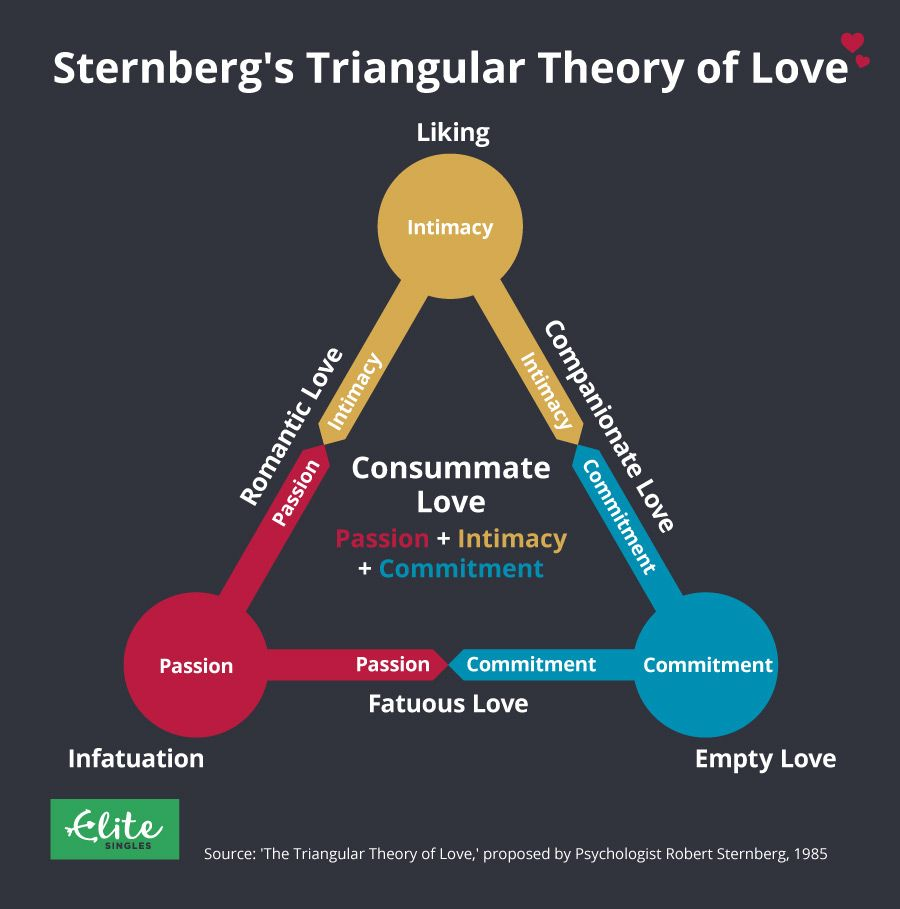Social Psychology - Part III
5.0(1)
5.0(1)
Card Sorting
1/84
There's no tags or description
Looks like no tags are added yet.
Study Analytics
Name | Mastery | Learn | Test | Matching | Spaced |
|---|
No study sessions yet.
85 Terms
1
New cards
Attitude
= learned, stable like/dislike of something
composed of:
1. cognition (thoughts)
2. affect (emotion)
3. behavior (action)
composed of:
1. cognition (thoughts)
2. affect (emotion)
3. behavior (action)
2
New cards
Halo Effect
= giving a person more credit or less suspicion than deserved because of past positive experiences with them
3
New cards
through social learning
How are Attitudes Formed?
4
New cards
Persuasion
= an active and conscious effort to change attitudes with a message
5
New cards
Persuasive Cues
1. communicator
2. message
3. how the message is communicated
4. audience
6
New cards
Central Route
= carefully scrutinizing the actual content of the message
* considering how the message fits with previous info, if it’s relevant, and how it affects the person
* considering how the message fits with previous info, if it’s relevant, and how it affects the person
7
New cards
1. motivation (if relevant, more likely to)
2. personality (if you’re usually analytical, more likely to)
Why do people take the central route of reasoning?
8
New cards
* accessible (easily recalled)
* persistent/stable over time
* resistant (to opposing messages)
* predict behavior (attitude influences behavior)
* persistent/stable over time
* resistant (to opposing messages)
* predict behavior (attitude influences behavior)
How are the resulting attitudes from the Central Route?
9
New cards
Peripheral Route
= when you’re not paying attention to the actual content of the message and are more influenced by superficial factors (looks, status, relatability)
→ leads to more impulsive actions, but also less permanent attitudes
→ leads to more impulsive actions, but also less permanent attitudes
10
New cards
Cognitive Consistency
= behavior that matches attitude
→ satisfaction
ex. worried about climate change, so ride bike → pleased with own action
→ satisfaction
ex. worried about climate change, so ride bike → pleased with own action
11
New cards
Cognitive Dissonance
= behavior does NOT match attitude
→ discomfort
ex. worried about climate change, but drive big truck for work → feel like hypocrite
→ discomfort
ex. worried about climate change, but drive big truck for work → feel like hypocrite
12
New cards
Positive Change in Attitude
a way to resolve tension of cognitive dissonance
= changing attitude to match good behavior
ex. grew up hating yankees fan, but your amazing roommate loves yankees, so you decide they aren’t all bad
= changing attitude to match good behavior
ex. grew up hating yankees fan, but your amazing roommate loves yankees, so you decide they aren’t all bad
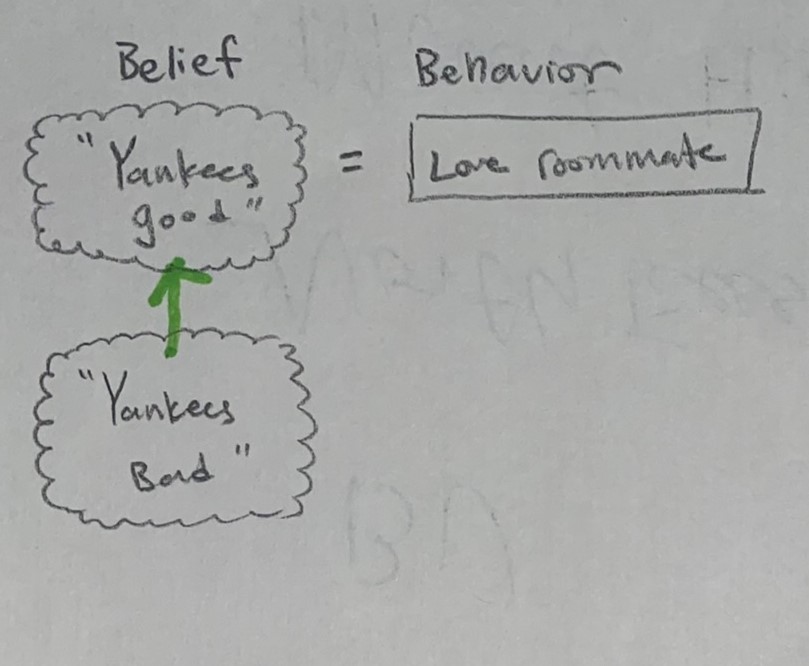
13
New cards
Negative Change in Attitude
a way to resolve tension of cognitive dissonance
= changing attitude to match/justify negative behavior
ex. believing vaping is bad, but addicted, so you decide vaping isn’t dangerous
= changing attitude to match/justify negative behavior
ex. believing vaping is bad, but addicted, so you decide vaping isn’t dangerous
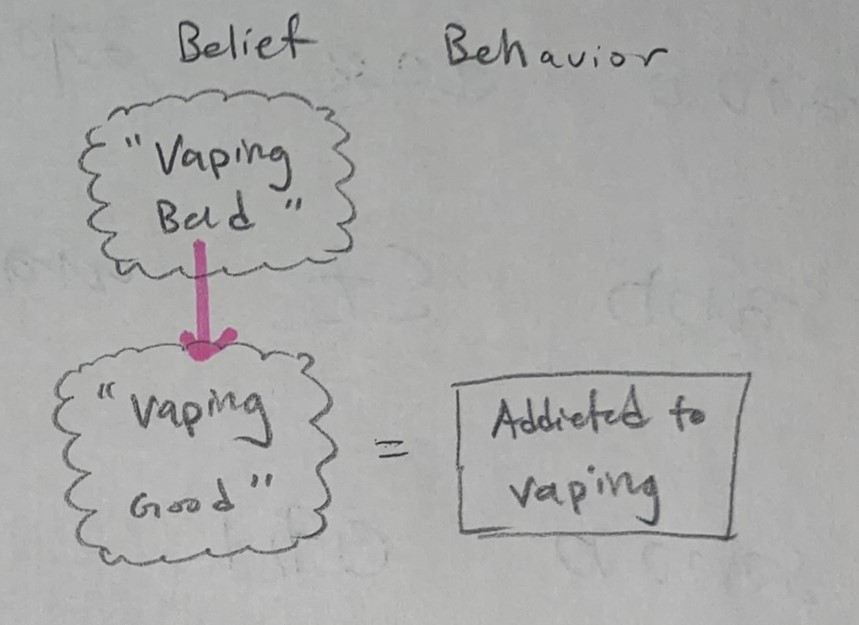
14
New cards
Positive Change in Behavior
a way to resolve tension of cognitive dissonance
= changing behavior from maladaptive to beneficial to match positive belief
= changing behavior from maladaptive to beneficial to match positive belief

15
New cards
Negative Change in Behavior
a way to resolve tension of cognitive dissonance
= changing behavior from beneficial to maladaptive to match negative belief
= changing behavior from beneficial to maladaptive to match negative belief
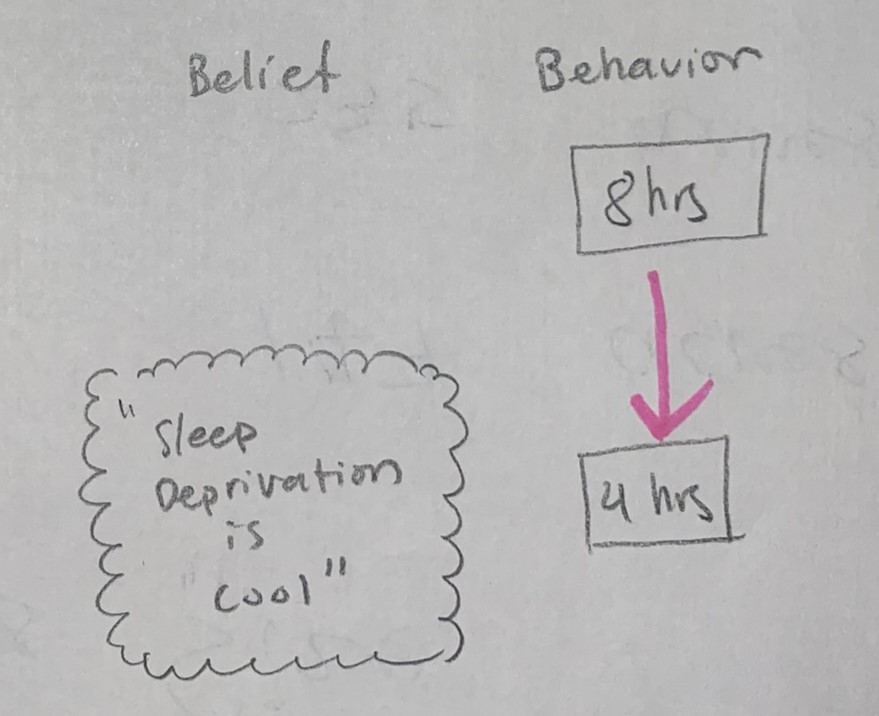
16
New cards
Self-Perception Theory
examining our actions then deciding what attitude we must have
* explains the formation of attitudes when we have a weak preference/knowledge about it
\
ex. observing that you don’t eat broccoli and thinking, “hm, I must not like broccoli”
* explains the formation of attitudes when we have a weak preference/knowledge about it
\
ex. observing that you don’t eat broccoli and thinking, “hm, I must not like broccoli”
17
New cards
Social Cognition
= using info to make inferences about self and others
\
“social thinking”
\
when it works well:
* best friend introduces you to their friends, so you trust your bsf’s judgement and assume the mutuals are cool, too
\
when it fails:
* using stereotypes to assume things about others
\
“social thinking”
\
when it works well:
* best friend introduces you to their friends, so you trust your bsf’s judgement and assume the mutuals are cool, too
\
when it fails:
* using stereotypes to assume things about others
18
New cards
Person-Perception
a theory to explain social cognition
= making judgement about others based on first impressions
\
connection to cognition/memory unit: Primacy Effect = remembering the __first__ impressions of people better
= making judgement about others based on first impressions
\
connection to cognition/memory unit: Primacy Effect = remembering the __first__ impressions of people better
19
New cards
Attribution
a theory to explain social cognition
= how people explain others’ actions
\
Recall (from personality unit): situational vs. dispositional attribution
= how people explain others’ actions
\
Recall (from personality unit): situational vs. dispositional attribution
20
New cards
Attribution Heuristics
a theory to explain social cognition
= when people use availability and representative heuristics to make assumptions about others’ actions
= when people use availability and representative heuristics to make assumptions about others’ actions
21
New cards
Fundamental Attribution Error
a problematic attribution heuristic
= tendency to make dispositional attributions and underestimate the role of situational factors
= misjudging someone by their supposed personality trait (disposition) when in actuality their action was caused by a specific situation (situational factor)
ex.
\*car swerves into your lane\*
“that driver is a __terrible driver__!” (personality trait)
but it’s actually due to __a deer in the road__ (situation)
= tendency to make dispositional attributions and underestimate the role of situational factors
= misjudging someone by their supposed personality trait (disposition) when in actuality their action was caused by a specific situation (situational factor)
ex.
\*car swerves into your lane\*
“that driver is a __terrible driver__!” (personality trait)
but it’s actually due to __a deer in the road__ (situation)
22
New cards
Self-Serving Bias
a problematic attribution heuristic
= tendency to make %%**dispositional** attributions for our positive behaviors%% and ==**situational** attributions to our negative behaviors== to feel good about ourselves
\
ex.
give %%amazing performance%% at your piano recital → “I must have worked hard!” (disposition)
recital ==does not go well== → “the piano must have been mistuned…” (situational)
= tendency to make %%**dispositional** attributions for our positive behaviors%% and ==**situational** attributions to our negative behaviors== to feel good about ourselves
\
ex.
give %%amazing performance%% at your piano recital → “I must have worked hard!” (disposition)
recital ==does not go well== → “the piano must have been mistuned…” (situational)
23
New cards
Social Desirability
a problematic attribution heuristic
= when judging others, we are more influenced by ==negative== behaviors than %%positive%%
= when judging others, we are more influenced by ==negative== behaviors than %%positive%%
24
New cards
Self-Handicapping
a problematic attribution heuristic
= attributing negative outcomes to situational factors
* serves as a protective mechanism for fragile self-esteem
* “premeditated excuse making” so that the person does not have to admit their lack of skill
= attributing negative outcomes to situational factors
* serves as a protective mechanism for fragile self-esteem
* “premeditated excuse making” so that the person does not have to admit their lack of skill
25
New cards
Behavioral Self-Handicapping
a problematic attribution heuristic
= acting in ways that reduce the likelihood of success so that if you fail, you can blame it on obstacles rather than ability
\
ex. pulling an all-nighter before a test
= acting in ways that reduce the likelihood of success so that if you fail, you can blame it on obstacles rather than ability
\
ex. pulling an all-nighter before a test
26
New cards
Reported Self-Handicapping
a problematic attribution heuristic
= rather than creating obstacles to success, people devise ready-made excuses in case they fail
ex. complaining about not feeling well before taking a test
= rather than creating obstacles to success, people devise ready-made excuses in case they fail
ex. complaining about not feeling well before taking a test
27
New cards
Just World Phenomenon
a problematic attribution heuristic
= a protective mechanism and tendency to think that the universe has an inherent balance
* people get what they deserve
* good things happen to good people
* bad things happen to bad people
\
Results in victim-blaming!
* allows people to attribute the misfortunes of others to *their* mistake in judgement
* “*I* would never do that, so it can’t happen to *me*”
= a protective mechanism and tendency to think that the universe has an inherent balance
* people get what they deserve
* good things happen to good people
* bad things happen to bad people
\
Results in victim-blaming!
* allows people to attribute the misfortunes of others to *their* mistake in judgement
* “*I* would never do that, so it can’t happen to *me*”
28
New cards
Schema
a theory to explain social cognition
= using general ideas (stereotypes) to judge people
= using general ideas (stereotypes) to judge people
29
New cards
Self-Fulfilling Prophecy
= when we have expectations about ourselves or others, we may consciously or subconsciously act in ways that are consistent with these expectations
= an individual changing their behavior based on how others treat/view them
\
ex. Rosenthal’s 3 level classroom experiment
at start of school year, told teachers this class was “behind, normal, or advanced” when they were all on the same level
at end of year, tested and the kids’ scores reflected that expectation
= an individual changing their behavior based on how others treat/view them
\
ex. Rosenthal’s 3 level classroom experiment
at start of school year, told teachers this class was “behind, normal, or advanced” when they were all on the same level
at end of year, tested and the kids’ scores reflected that expectation
30
New cards
Social Comparison
= evaluating yourself by comparing to others
31
New cards
Stereotype Threat
an example of self-fulfilling prophecy
= when people belong to a group about which others have a negative stereotype
* when group members are aware of the negative stereotype, their reduced performance reflects the reduced expectations of others
* researched by Claude Steele
* due to overactivity in limbic system (anxiety) which hinders activity in prefrontal cortex, which is necessary to perform well on tests
= when people belong to a group about which others have a negative stereotype
* when group members are aware of the negative stereotype, their reduced performance reflects the reduced expectations of others
* researched by Claude Steele
* due to overactivity in limbic system (anxiety) which hinders activity in prefrontal cortex, which is necessary to perform well on tests
32
New cards
Social Influence
how others’ behaviors affect an individual
33
New cards
**Conformity**
= adapting your behavior to match others’
* indirect pressure / peer pressure
%%Helpful%%:
* useful when moving to new environment for adopting social norms of new group
* ex. different colleges or businesses have different ideas about appropriate clothing
==Harmful==:
* peer pressure for risky behaviors
* ex. drinking / hazing
* indirect pressure / peer pressure
%%Helpful%%:
* useful when moving to new environment for adopting social norms of new group
* ex. different colleges or businesses have different ideas about appropriate clothing
==Harmful==:
* peer pressure for risky behaviors
* ex. drinking / hazing
34
New cards
Asch’s Conformity Experiment
* a group of students all looked at 1 vertical bar and then asked to compare it to 3 other bars of different lengths
\
* They were asked which of the 3 were the same as the left one
* HOWEVER, only 1 student was the subject, everyone else was a confederate who were told to occasionally choose the wrong bar
Results:
* at least some of the time, the subject changed his answer despite believing others were incorrect in their judgment
* after 3+ people making the wrong choice, the subject felt more pressure to conform to the group’s answer
\
* They were asked which of the 3 were the same as the left one
* HOWEVER, only 1 student was the subject, everyone else was a confederate who were told to occasionally choose the wrong bar
Results:
* at least some of the time, the subject changed his answer despite believing others were incorrect in their judgment
* after 3+ people making the wrong choice, the subject felt more pressure to conform to the group’s answer
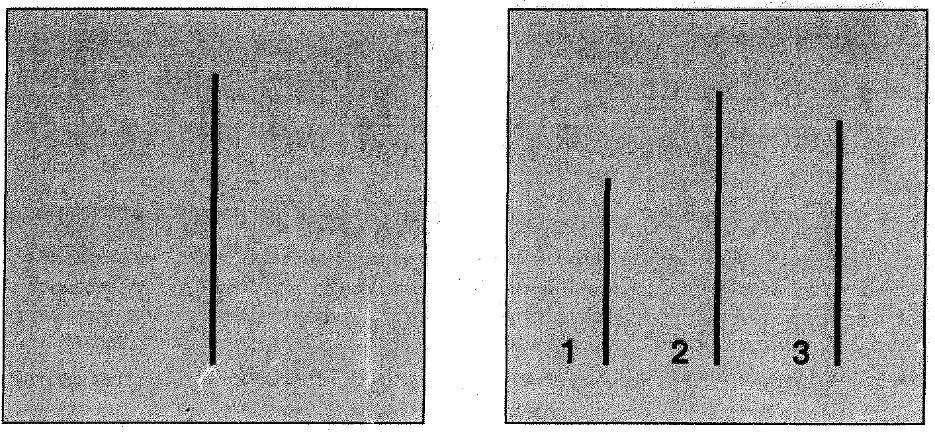
35
New cards
Group Desirability
a Factor that Contributes to Conformity
= How much the individual wants to belong to the group
= How much the individual wants to belong to the group
36
New cards
Group Cohesiveness
a Factor that Contributes to Conformity
= How “tight” the group is
\
ex. 10 close friends are more likely to conform to the same idea than 10 classmates
= How “tight” the group is
\
ex. 10 close friends are more likely to conform to the same idea than 10 classmates
37
New cards
Group Size
a Factor that Contributes to Conformity
= Small groups of 3-5 increase conformity (because no one wants to be the one who disagrees) / Large groups increase conformity (because of “mob mentality” and the belief that any 1 person’s actions are unidentifiable in a crowd
= Small groups of 3-5 increase conformity (because no one wants to be the one who disagrees) / Large groups increase conformity (because of “mob mentality” and the belief that any 1 person’s actions are unidentifiable in a crowd
38
New cards
Visible Behavior
a Factor that Contributes to Conformity
= Increases conformity
ex. this is why democracies have secret ballots
= Increases conformity
ex. this is why democracies have secret ballots
39
New cards
Ambiguous Expectations
a Factor that Contributes to Conformity
= Low knowledge about a situation increase conformity (because people are unsure of what they are supposed to do and believe others know better)
= Low knowledge about a situation increase conformity (because people are unsure of what they are supposed to do and believe others know better)
40
New cards
**Compliance**
= Submitting to direct social pressure (ex. a request from another person)
41
New cards
Foot-in-the-door Technique
**=** a compliance technique where a small request is made first and is then followed up with a larger one
ex. if someone is asked to sign a petition first, then they are more likely to comply when asked to make a small donation
ex. if someone is asked to sign a petition first, then they are more likely to comply when asked to make a small donation
42
New cards
Door-in-the-face Technique
= a compliance technique, making a large request that the person will likely turn down hoping they will agree to a second and more reasonable request
43
New cards
**Obedience**
= following the demand of an authority figure
* there is generally a threat of punishment (perceived or not) if the command is not followed
* alternatively, following demand might hold the promise of a reward (perceived or not)
* there is generally a threat of punishment (perceived or not) if the command is not followed
* alternatively, following demand might hold the promise of a reward (perceived or not)
44
New cards
Milgram’s experiment
* subject asked to shock the person if they made mistake, another authority figure encouraged subject to continue (shock level given increased each time)
* 2/3 continued to lethal levels while 1/3 disagreed and stopped shocking
* 2/3 continued to lethal levels while 1/3 disagreed and stopped shocking
45
New cards
Group Behavior
= How people act in a group / how being a member affects behavior
46
New cards
Social Dilemma
= Decision-Making question for individuals when they work in a group: do you opt for the immediate, individual reward, or do you work to get the long-term benefits for the entire group?

47
New cards
Social Trap
= unproductive actions of individuals that hurt the group, because they fear “If I don’t do it, someone else will and so they will get the benefit and I will lose”
* when people choose the immediate, individual benefit, they may fall into the **__** of hurting themselves and the rest of the group in the future
* when people choose the immediate, individual benefit, they may fall into the **__** of hurting themselves and the rest of the group in the future
48
New cards
Tragedy of the Commons
= social trap that develops when a group shares a limited resource
49
New cards
Social Facilitation and Social Inhibition
= How an audience affects your performance
* if Dominant Response is correct or easy → %%Social Facilitation%%
* if Dominant Response is incorrect or difficult → ==Social Inhibition==
\
* if Dominant Response is correct or easy → %%Social Facilitation%%
* if Dominant Response is incorrect or difficult → ==Social Inhibition==
\
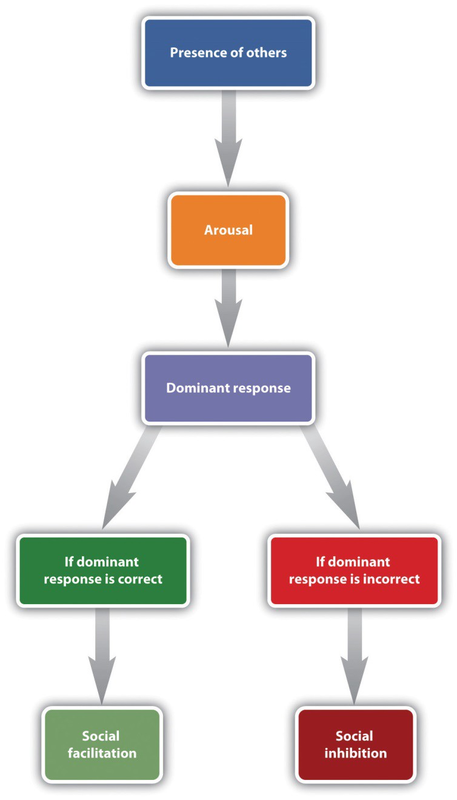
50
New cards
Group Polarization
= the actions/beliefs of a group are more exaggerated than the individual members’ typical behaviors or thoughts
Effects:
1. Groups made up of risk-takers choose more dangerous group activities
ex. college student who likes scary activities thinks that bungee jumping would be a good spring break. When he gets together with like-minded friends, they choose naked bungee jumping into a pit of venomous snakes
2. Groups composed of risk-averse people choose even less riskier group activities
Effects:
1. Groups made up of risk-takers choose more dangerous group activities
ex. college student who likes scary activities thinks that bungee jumping would be a good spring break. When he gets together with like-minded friends, they choose naked bungee jumping into a pit of venomous snakes
2. Groups composed of risk-averse people choose even less riskier group activities
51
New cards
**Groupthink**
= when all members of the group think similarly or are scared to voice an opposing opinion, the group often makes poor decisions
52
New cards
Social Loafing
= when people tend to exert less effort to achieve a goal when they work in a group than when working alone (usually when each individual’s contribution is not obvious)
ex. in the tug of war example, loafing was exacerbated when everyone was blindfolded
ex. in the tug of war example, loafing was exacerbated when everyone was blindfolded

53
New cards
Bystander Effect
= the phenomenon where the more people who witness an event, the less likely it is that anyone will respond
due to **Diffusion of Responsibility** and **Pluralistic Ignorance**
due to **Diffusion of Responsibility** and **Pluralistic Ignorance**
54
New cards
Diffusion of Responsibility
= when an individual sense of responsibility decreases in the presence of others
* alone = 100% responsible
* in a group of 5 = each think they are 20% responsible
* The more people involved, the more likely it is that each person will do nothing, believing someone else from the group will probably respond
\
* alone = 100% responsible
* in a group of 5 = each think they are 20% responsible
* The more people involved, the more likely it is that each person will do nothing, believing someone else from the group will probably respond
\
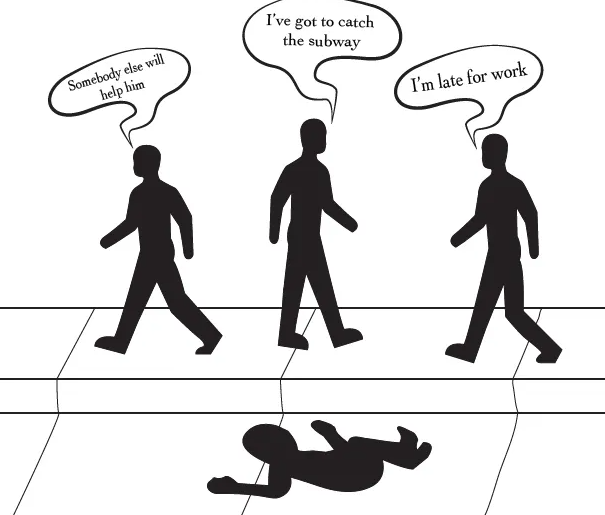
55
New cards
Pluralistic Ignorance
= assuming nothing is wrong because nobody else looks concerned
56
New cards
**Deindividuation**
= stop thinking about people as individuals
\
1. We reduce others to less-than-human
1. tactic often used intentionally by genocide leaders
2. We stop thinking about ourselves as an individual with responsibilities (and choice) and just accept the role we’ve been given
3. We assume we are unidentifiable in a crowd (and then behave in ways we would if we knew we could be identified)
1. social media anonymity → trolls/cyberbllying
\
1. We reduce others to less-than-human
1. tactic often used intentionally by genocide leaders
2. We stop thinking about ourselves as an individual with responsibilities (and choice) and just accept the role we’ve been given
3. We assume we are unidentifiable in a crowd (and then behave in ways we would if we knew we could be identified)
1. social media anonymity → trolls/cyberbllying
57
New cards
Anti-social
= behavior that is harmful to society or certain individuals in society
* does NOT mean introverted or shy
Connection to Personality Unit: Anti-social Personality Disorder
* does NOT mean introverted or shy
Connection to Personality Unit: Anti-social Personality Disorder
58
New cards
Prejudice
= judging a person based on beliefs about the group(s) that the person identifies with
* are learned - via observational learning or operant conditioning
* in the US, mainly based on race, in other parts of the world, based on religion
* usually negative but can also be unfairly positive (some people are more respected just because of the group they belong to)
Attitudes → prejudice → antisocial actions (discrimination)
* are learned - via observational learning or operant conditioning
* in the US, mainly based on race, in other parts of the world, based on religion
* usually negative but can also be unfairly positive (some people are more respected just because of the group they belong to)
Attitudes → prejudice → antisocial actions (discrimination)
59
New cards
Social Categories
= broad groupings based on obvious characteristics such as age, skin color, gender, etc.
* neither inherently negative or positive
* neither inherently negative or positive
60
New cards
**Stereotypes**
= overly broad descriptions of different social categories
* once stereotype is established, people will use that generalized characterization of an entire group to make predictions about the behaviors, skills, or attitudes, of every individual in the group
ex. all old people are lousy drivers → that old person trying to park next to my car will probably hit it
* once stereotype is established, people will use that generalized characterization of an entire group to make predictions about the behaviors, skills, or attitudes, of every individual in the group
ex. all old people are lousy drivers → that old person trying to park next to my car will probably hit it
61
New cards
**Ingroup**
= “Us" / you and others who you think share important traits/beliefs with you
62
New cards
**Outgroup**
= “Them” / people you see as different from yourself
63
New cards
### Ingroup-Outgroup Bias
* memberships in groups change based on the circumstances:
* At a pep rally, seniors are the ingroup while other grades are the outgroup
* At a game, all SHS students are the ingroup while the Foxboro team and their fans are the outgroup
* At a Patriots’ game, SHS fans + Foxboro fans are the ingroup while the Bills fans are the outgroup
\
* At a pep rally, seniors are the ingroup while other grades are the outgroup
* At a game, all SHS students are the ingroup while the Foxboro team and their fans are the outgroup
* At a Patriots’ game, SHS fans + Foxboro fans are the ingroup while the Bills fans are the outgroup
\
64
New cards
**Outgroup Homogeneity Bias**
= Seeing people in the outgroup as the same (meanwhile we see everyone in the ingroup as a unique individual)
\
\
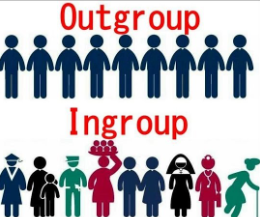
65
New cards
Competition for Resources
### a Theory to Explain Prejudice
= people who are seen as depriving you of something tend to be disliked, stereotyped as “undeserving,” then mistreated
ex. throughout US history, low-wage workers disliked immigrants
= people who are seen as depriving you of something tend to be disliked, stereotyped as “undeserving,” then mistreated
ex. throughout US history, low-wage workers disliked immigrants
66
New cards
Social Identity
### a Theory to Explain Prejudice
= belonging to certain social groups, together with some emotional and valuational significance of that group membership (envy, pride, etc)
* Being part of a group increases self-esteem and so people automatically form ingroups and outgroups
* Individuals who don’t have many positive factors in their life sometimes form ingroups simply based on the idea of “at least we’re not ______”.
* As a result, their ingroup beliefs and activities revolve around prejudice and discrimination
= belonging to certain social groups, together with some emotional and valuational significance of that group membership (envy, pride, etc)
* Being part of a group increases self-esteem and so people automatically form ingroups and outgroups
* Individuals who don’t have many positive factors in their life sometimes form ingroups simply based on the idea of “at least we’re not ______”.
* As a result, their ingroup beliefs and activities revolve around prejudice and discrimination
67
New cards
### Results of Prejudice
###
1. Individuals are excluded from education, housing, jobs, etc, because of the *group* they belong to and NOT because of their *own skills, efforts, etc.*
2. Individuals might internalize negative stereotypes
1. and adopt antisocial behaviors
2. and be harmed by the self-fulfilling prophecy
3. Individuals who don’t match the positive stereotypes of the group may experience anxiety or low self-esteem
ex. an Italian who is a lousy cook → low confidence
\
1. Individuals are excluded from education, housing, jobs, etc, because of the *group* they belong to and NOT because of their *own skills, efforts, etc.*
2. Individuals might internalize negative stereotypes
1. and adopt antisocial behaviors
2. and be harmed by the self-fulfilling prophecy
3. Individuals who don’t match the positive stereotypes of the group may experience anxiety or low self-esteem
ex. an Italian who is a lousy cook → low confidence
\
68
New cards
### Ways to Reduce Prejudice
1. People can learn to ignore a stereotype and remember to evaluate everyone they meet as an individual
2. Exposing individuals, especially when they are young, to people whoa re different in some way → increases acceptance of differences
1. Connects to the **Mere Exposure Effect** = phenomenon by which people tend to develop a preference for things or people that are more familiar to them than others. Repeated exposure increases familiarity
\
3. Critical thinking about history, prejudices, and personal experiences helps to reduce prejudice
1. it’s a skill that can be taught!
69
New cards
Mere Exposure Effect
= phenomenon by which people tend to develop a preference for things or people that are more familiar to them than others. Repeated exposure increases familiarity
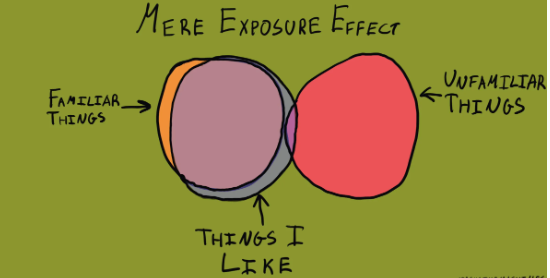
70
New cards
Robber’s Cave
= Study in the 1950s by Muzafer Sherif
* 11-year old boys at a summer camp (called the Robber’s Cave)
Phase 1:
* randomly divided into 2 groups that were isolated from each other
* developed sense of cohesion in each group
Phase 2:
* 2 groups competed for highly-desired prizes (pocket knives, medals, etc)
* conflict escalated from name calling (“cowards!”) to direct acts of sabotage
* negative attitudes/behaviors
Phase 3:
* 2 groups brought together to work on superordinate goals (a goal that can be attained only if the members of two or more groups work together by pooling their skills, efforts, and resources)
ex. restoring the camp’s water supply
* tensions between groups dissolved by day 6
\
__Results:__
1. Ingroup-Outgroup rivalries can develop quickly between groups that had no previous animosity
2. Social identity is an important source of prejudice
3. Prejudice and discrimination can be reduced by having the opposing groups work together to solve a problem that both groups face
* 11-year old boys at a summer camp (called the Robber’s Cave)
Phase 1:
* randomly divided into 2 groups that were isolated from each other
* developed sense of cohesion in each group
Phase 2:
* 2 groups competed for highly-desired prizes (pocket knives, medals, etc)
* conflict escalated from name calling (“cowards!”) to direct acts of sabotage
* negative attitudes/behaviors
Phase 3:
* 2 groups brought together to work on superordinate goals (a goal that can be attained only if the members of two or more groups work together by pooling their skills, efforts, and resources)
ex. restoring the camp’s water supply
* tensions between groups dissolved by day 6
\
__Results:__
1. Ingroup-Outgroup rivalries can develop quickly between groups that had no previous animosity
2. Social identity is an important source of prejudice
3. Prejudice and discrimination can be reduced by having the opposing groups work together to solve a problem that both groups face
71
New cards
**Aggression**
= intentionally hurting someone else either physically or psychologically
72
New cards
**Hostile Aggression**
= harming others as part of __maladaptive coping__ (coping strategies or behaviors that are ineffective, harmful, or counterproductive in dealing with stress, adversity, or difficult situations)
73
New cards
**Instrumental Aggression**
= using force to gain a goal, planned and controlled
ex. being aggressive in asking for a raise/on a debate team
ex. being aggressive in asking for a raise/on a debate team
74
New cards
Biological Reasons
### a theory to Explain Aggression
1. Aggression is a normal part of all organisms to protect themselves, their young, their home/territory
2. Higher levels of testosterone increase aggression
1. Aggression is a normal part of all organisms to protect themselves, their young, their home/territory
2. Higher levels of testosterone increase aggression
75
New cards
Response to Environment
### a theory to Explain Aggression
1. Aggression resulting from frustration, discomfort, etc. is hostile aggression
Ex. Small children lash out when they are tired or hungry
2. Some children learn to be aggressive by watching others (social learning) or by getting what they want when they are aggressive
Ex. The kid who steals lunch money and gets away with it
1. Aggression resulting from frustration, discomfort, etc. is hostile aggression
Ex. Small children lash out when they are tired or hungry
2. Some children learn to be aggressive by watching others (social learning) or by getting what they want when they are aggressive
Ex. The kid who steals lunch money and gets away with it
76
New cards
### Ways to Reduce Aggression
1. Decrease opportunities for deindividuation
2. Provide positive social learning experiences (i.e., role models)
3. Induce cognitive dissonance in people with aggression (so change their beliefs so they know their actions are wrong in the hope that they might fix their behavior to be congruent with their new beliefs)
4. Use Cognitive-Behavioral Therapy to help aggressive individuals respond more rationally to frustration and others’ actions
77
New cards
Pro-social Behavior
= behavior that is __**helpful**__ to society
78
New cards
**Altruism**
= the unselfish regard for the welfare of others
those who are altruistic might put themselves in danger, do not expect a reward/are not doing it as their job
those who are altruistic might put themselves in danger, do not expect a reward/are not doing it as their job
79
New cards
**Volunteering**
= Working without pay to help others
80
New cards
## ^^Factors that Increase Pro-social Behavior^^
1. Realizing you’re in a situation where someone else needs your help
2. Having the time to engage in prosocial actions
3. Seeing yourself as similar to the person in need of help
* This helps explain why Americans reacted more to the genocide in Bosnia than in Rwanda and why @@**it’s important to teach people to see others as part of their ingroup**@@
4. Understanding that prosocial behavior also has positive outcomes for the person performing the good deeds
81
New cards
Similarity
a cause of attraction
= when we are drawn to people with similar interests, backgrounds, or beliefs
= when we are drawn to people with similar interests, backgrounds, or beliefs
82
New cards
Proximity
a cause of attraction
= increased likelihood of dating someone who lives near you and goes to school with you than someone across the country
* why long-distance relationships usually don’t work out (due to decreased ability to interact with each other) (and decrease in the mere exposure effect)
= increased likelihood of dating someone who lives near you and goes to school with you than someone across the country
* why long-distance relationships usually don’t work out (due to decreased ability to interact with each other) (and decrease in the mere exposure effect)
83
New cards
Exposure
a cause of attraction
= tendency to develop positive feelings about thing and people to which we are frequently exposed
ex. interacting with friend over and over → increased relationship
ex. also why advertising in marketing is so important
= tendency to develop positive feelings about thing and people to which we are frequently exposed
ex. interacting with friend over and over → increased relationship
ex. also why advertising in marketing is so important
84
New cards
### Ainsworth’s Attachment Theory
psychological explanation for the emotional bonds and relationships between people
\
* explains how people relate to friends and romantic partners
* Securely attached children tend to also have stable, long-term friendships and successful romantic partnerships
\
* explains how people relate to friends and romantic partners
* Securely attached children tend to also have stable, long-term friendships and successful romantic partnerships
85
New cards
### Sternberg’s Triarchic Theory of Love
